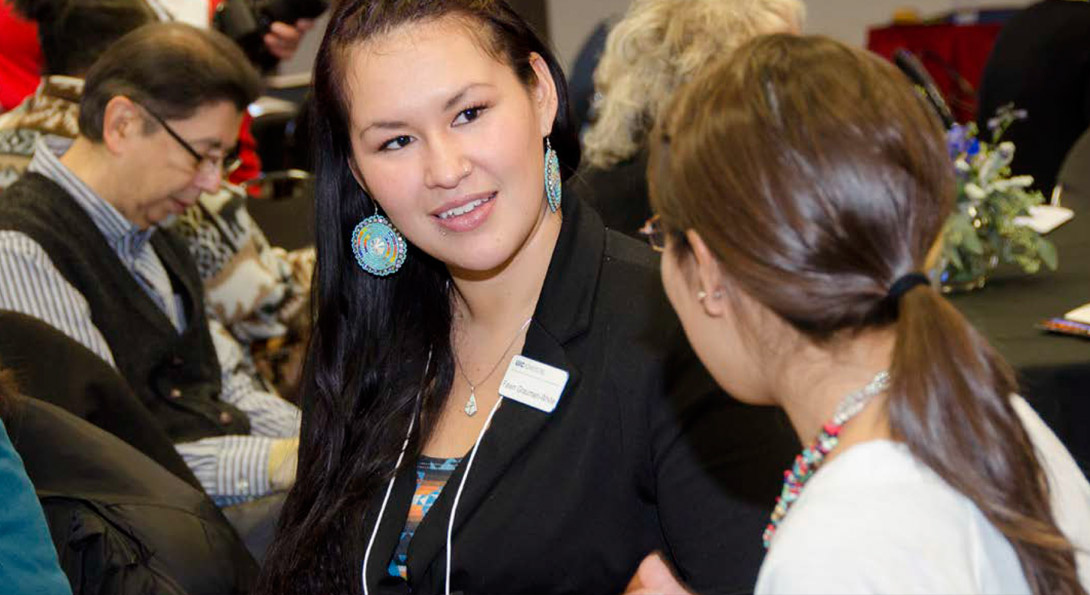Here Forever and Still Here: Native Americans at UIC

What is the status of Native Americans on the University of Illinois Chicago (UIC) campus? That was the question posed by Cynthia M. Soto, then-director of UIC’s Native American Support Program (NASP), to explore UIC’s commitment to its Native population across myriad key arenas. Convened by Amalia Pallares, Associate Chancellor and Vice Provost for Diversity, and Rex Tolliver, Vice Chancellor for Student Affairs, the task force spurred by Soto’s requests has just released its report. There’s lots of work to be done.
The report is the culmination of over a year of work spanning 2019-2021 that marked the 50th anniversary of the NASP, the oldest program of its kind in the state. Unique though it may be, the NASP has suffered more than its share of hardships through the years as it has struggled to remain a place where Native students, faculty and staff can access resources and feel a little less marginalized. A program can’t thrive and grow, said Soto, without having the resources to do so.
“There’s always budget cuts,” continued Soto, now the Initiatives Manager at the Spencer Foundation. “Cutting a professional development program for the director, or not financing a student worker. But yet enrollment is up across campus and there are new buildings everywhere.”
“A key recommendation of our report is that Native American Support Services receive additional funding and support,” said Teresa Córdova, Task Force Co-chair and Director of the Great Cities Institute and Professor of Urban Planning and Policy. “Their services are critical and without that kind of investment, we’ll never make the progress we need to increase Native American presence at UIC. And for a public institution on Indigenous land, this responsibility should be a given.”
“We have work to do to better represent the Indigenous community’s presence and history here on our campus,” agreed Josh Radinsky, Co-chair of the task force and an associate professor of Education and Learning Sciences. “Even the numbers we do have are often wrong and incomplete. While we focus on recruitment and retention, we also have concrete steps we can take to make Native students visible, make sure they are seen, and their voices are heard.”
One of the report’s six main sections, Data Visibility and Data Erasure: Documenting Native presence at UIC, illustrates why the numbers are skewed. Application forms commonly use the Integrated Postsecondary Education Data System (IPEDS), where students who selected more than one race category are reported as Multi-race. If they selected American Indian or Alaska Native (AIAN) plus another category, they are not counted as AIAN.
The problems of invisibility and misidentification are not limited to student data. The Native community at UIC has a strong desire for a more vibrant, visible and recognized presence on campus, says the sampling of Indigenous community members interviewed for the report. Though there is a 50-year history of Native presence, engagement and fighting for representation on campus, UIC lacks Indigenous scholars and staff, and Native American studies courses are few and far between. Then there’s the misconception that there are no Native Americans in Chicago.
“Native Americans have long been subjected to this kind of erasure,” said Córdova. “Through warfare, deceitful treaties, exclusion and social control, Indigenous people in Chicago were quickly relegated to the back pages of written history. But Chicago’s original people of the region remain, while others have come and made it their home.”
The report stresses the fundamental need to build and maintain strong connections between UIC and Native communities. These relationships, it explains, should be built with the local Chicagoland Native community as well as the Tribal Nations in the Great Lakes. The task force has charged UIC to work towards developing these relationships and commitments, given its history and mission as a land grant institution.
Despite the challenges, there is much to be hopeful for. With its ubiquitous involvement in all aspects of advocacy, the NASP is in the Native consciousness of the city; UIC and Northwestern jointly sponsor the Indigenous Writers Lecture Series, strengthening the bond across institutions; and UIC, in the heart of Chicago, has the potential to be the center of Indigenous scholarship for the Chicagoland area.
“We hope the report will create the political will to help make UIC a welcoming place for Natives both in Chicago and across the nation,” said Soto. “UIC has a new provost coming in and this is a great opportunity to demonstrate the university’s commitment to the Native American community in Chicago.”